This beautiful place wraps a history lesson with the leaves of the abundant trees and plants spread across 400 acres of ground, and a bow made of pink and red azaleas and camellias.
Take a walk through the lush landscape dotted with multicoloured flowers and wildlife, and you’ll see why Magnolia Plantation and Gardens is on the “Most beautiful gardens in America” list from major publications.
Magnolia is also on the National Register of Historic Places list. It’s the oldest public garden in America, the “Oldest man-made attraction in continuous operation”, and the oldest plantation on the Ashley River.
You can visit the gardens when you plan a trip to Charleston, in South Carolina. A 10-minute drive from downtown will take you to a slice of paradise, Southern style.
Disclosure: This post contains some affiliate links. If you make a purchase through those links I will earn a commission at no additional cost to you (zero, nada). To check the full disclaimer, click here.
Here’s what to see at Magnolia Plantation and Gardens, and the history behind it.
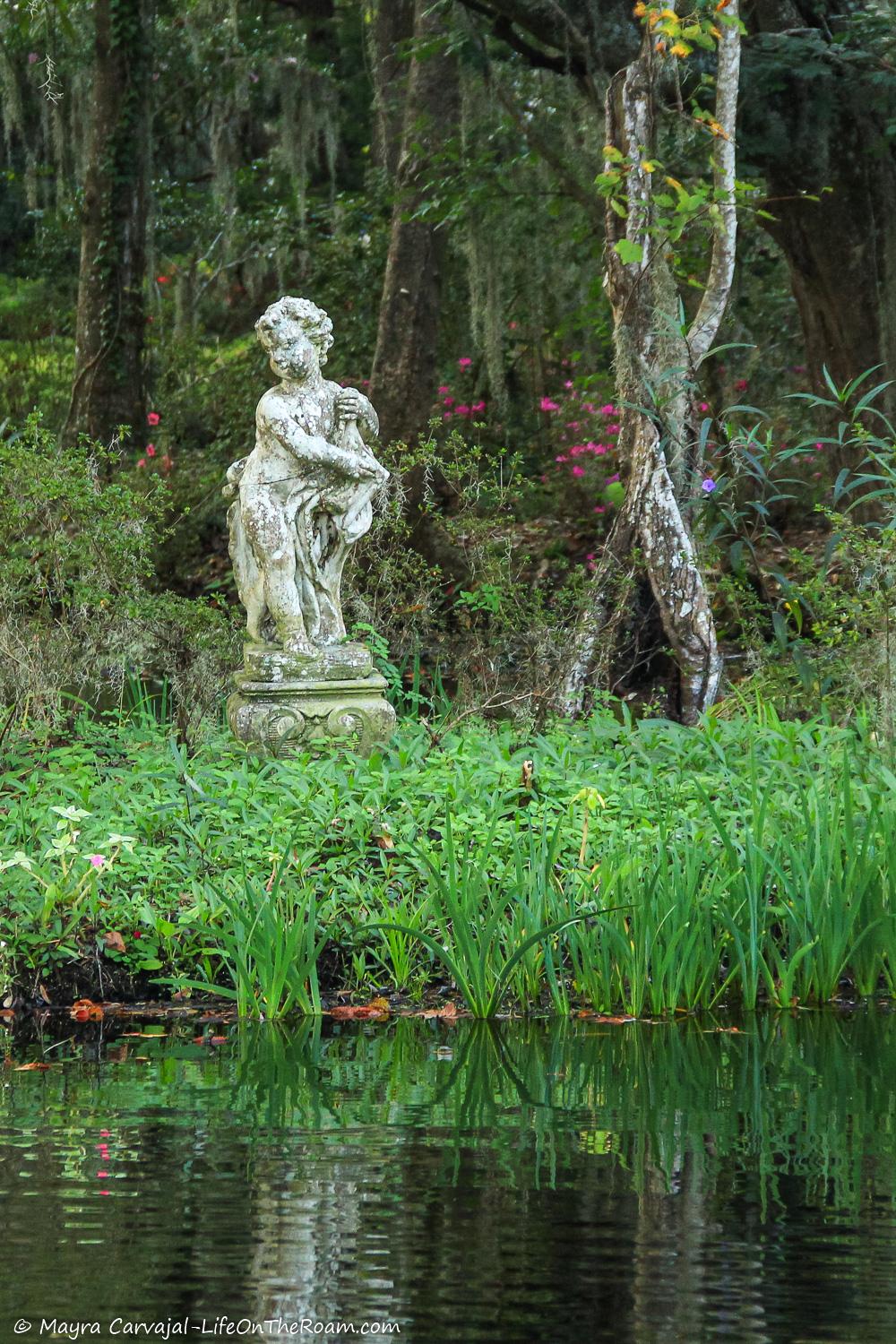
Table of Contents
Magnolia Plantation and Gardens: a Brief History
It all started in 1676 when the Drayton family became the owners of Magnolia, and have remained the only owners for centuries.
But it wasn’t until the 1870s that the property opened to the public.
The man who ran the show at that time was Rev. John G Drayton, the Rector of St. Andrews Episcopal Church.
Before the Civil War, the rice plantation was a successful business bringing tons of money. But then the war happened, putting an end to free labour (more on that later).
That, combined with the devastation of several hurricanes, and increased competition, decimated the fortune of the plantation owner.
What did Drayton do to survive after the rice days were over?
He decided to turn his garden into a tourist attraction.
The first visitors to what became the oldest public site in the Low Country arrived during the spring in paddlewheel steamers that would sail for one hour from Charleston every day, vs. a 3-hour road trip on a carriage bumpy ride.
Some arrived by train to the other side of the river and reached the dock on a ferry.
Quite an adventure compared to the short drive you take from downtown Charleston on Hwy 61 these days.
Today the Magnolia Plantation and Gardens efforts are geared towards wildlife protection, education and preservation.
The Gardens at Magnolia Plantation
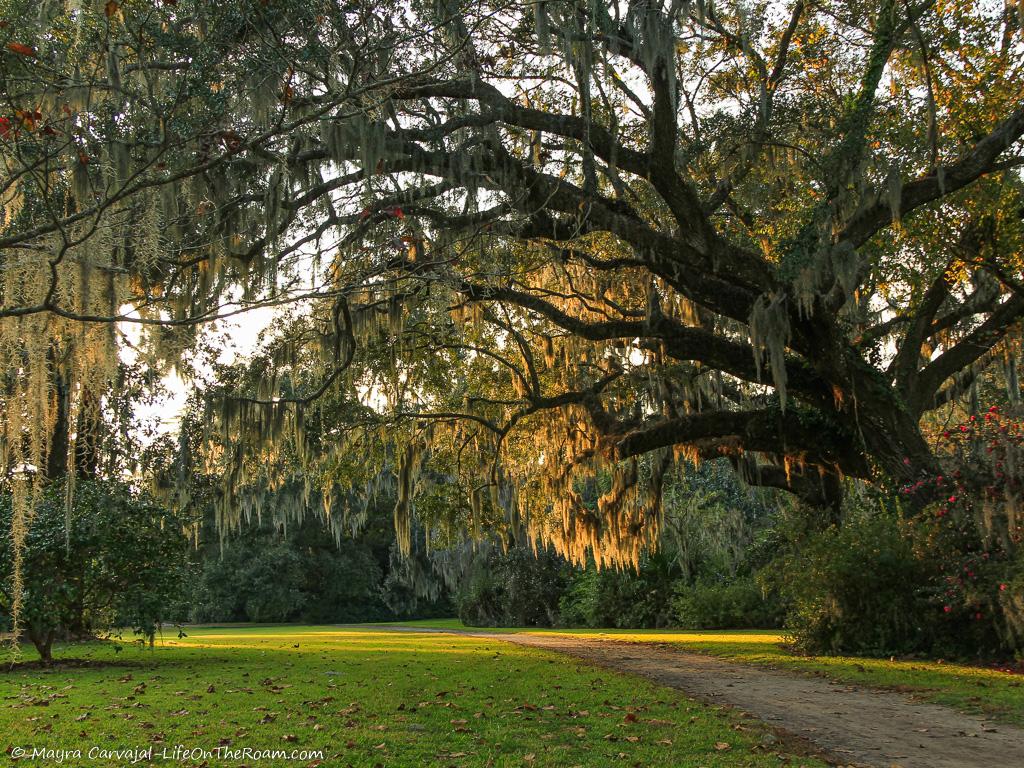
One thing you’ll notice across the 70 acres of gardens is that, compared to other gardens, nature runs on a long leash here.
Some gardens are formal, structured and manicured. They’re like a black-tie dinner where everything looks perfect.
These gardens are more like having a couple of beers on your best friend’s porch.
They’re not less beautiful, but they’re more relaxed.
And that’s exactly the intent behind the redesign: to let you feel nature as it is: unboxed, unconstrained, asymmetrical. Flowy.
Drayton transformed what was a French-style formal garden (the oldest formal garden in America) into the oldest informal, Romantic-style garden in America.
It’s designed as an all-season garden, with blooming plants in every season. You’ll find numbered posts along the way to guide your walk as well as interpretative plaques.
Only one section of the garden runs on a short leash: Flowerdale.
Flowerdale: the First Garden
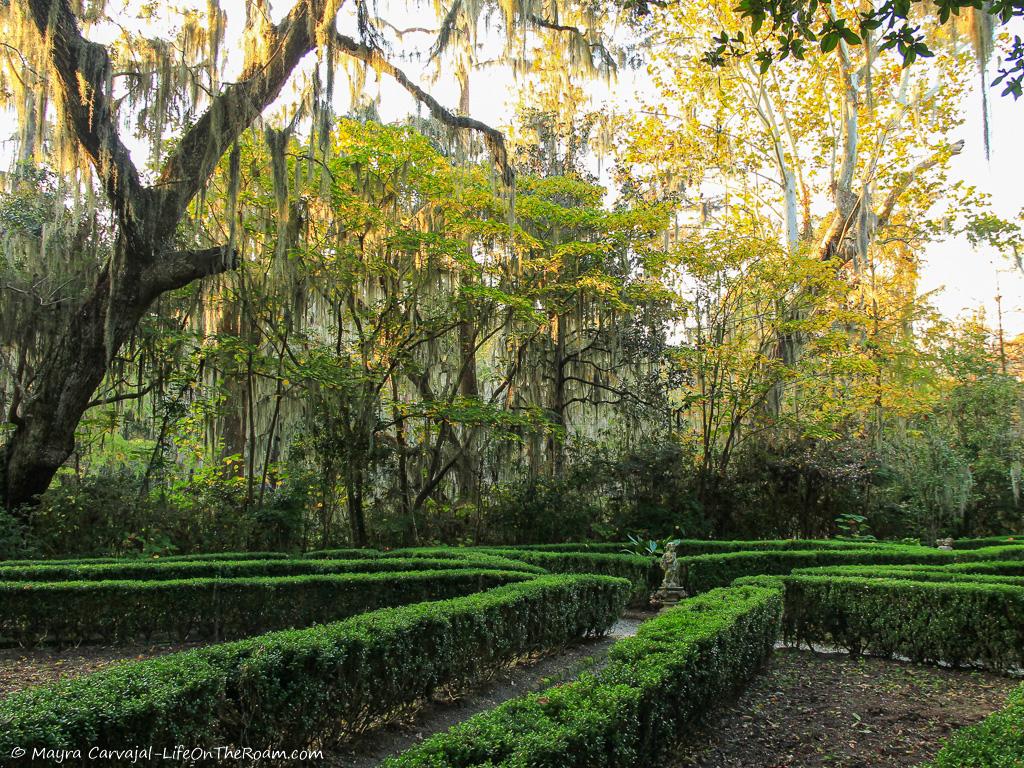
The walking paths around the lake near the house show a gamut of green shades making swirls on the water, resembling an enormous marble countertop.
One of the paths will lead you to Flowerdale, the first garden designed in the plantation in 1685 with a geometric pattern, English style.
This formal garden, with small statues spread across the paths, wins Magnolia the title of America’s oldest major garden. You can also see two of the largest Camelia plants in the country, dating back to the 1840s.
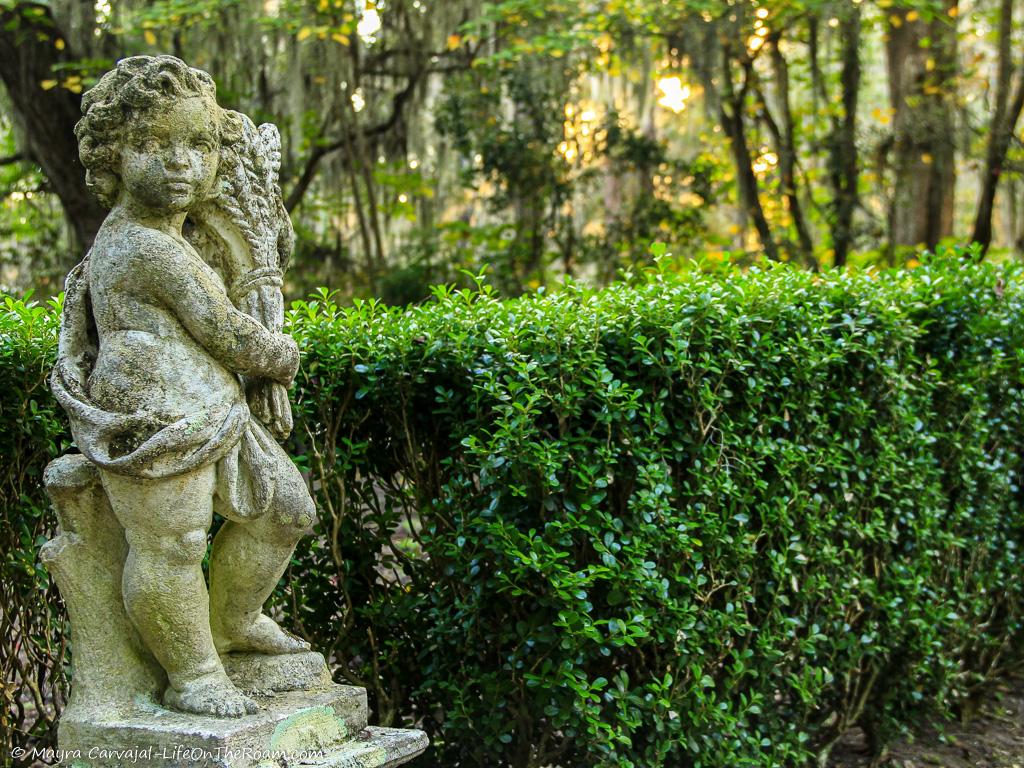
This is also next to the site of the first house built on the property (and the oldest in the Carolina colony). What happened to it? A fire burnt it to the ground.
The Biblical Garden

Wondering what type of plants and trees you could find in biblical times?
Wonder no more for you can stand in front of many species that were around thousands of years ago.
You can read the informative plaques listing the species and what verses of the bible mention it, as well as a historic reference.
You’ll see pomegranate trees (mentioned in Solomon), Oleanders (the “rose” of Ecclesiastes), and quince (which some believe was the “apple” in Genesis).
“The Long White Bridge”
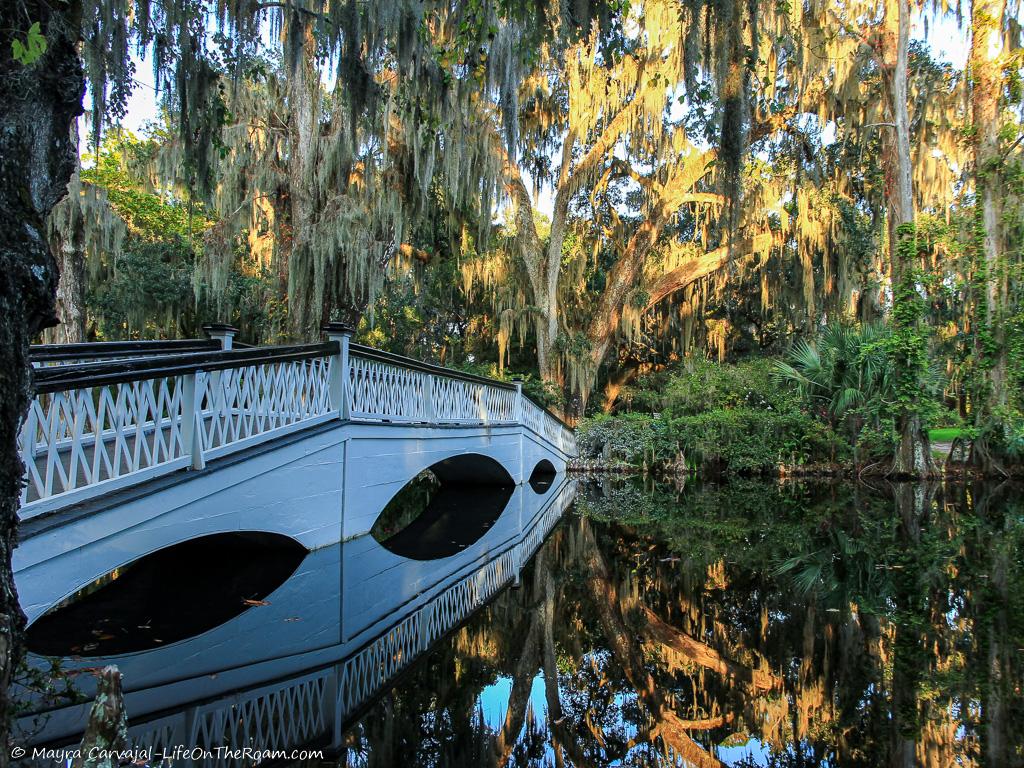
There were no brainstorming sessions to pick the name for this bridge. It’s long and it’s white, so there you have it.
Its surroundings are the typical postcard of the South. The lake, like a big black mirror, reflects the Spanish Moss hanging from the open wide arms of the tall live oak trees.
The landscape is lush, dense, and loose.

Keep your eyes peeled for the statues lurking in the garden and look carefully for a pair (or two) of yellow eyes looking at you. Turtles and alligators live here!
The Native Azalea Garden and the Horticultural Maze
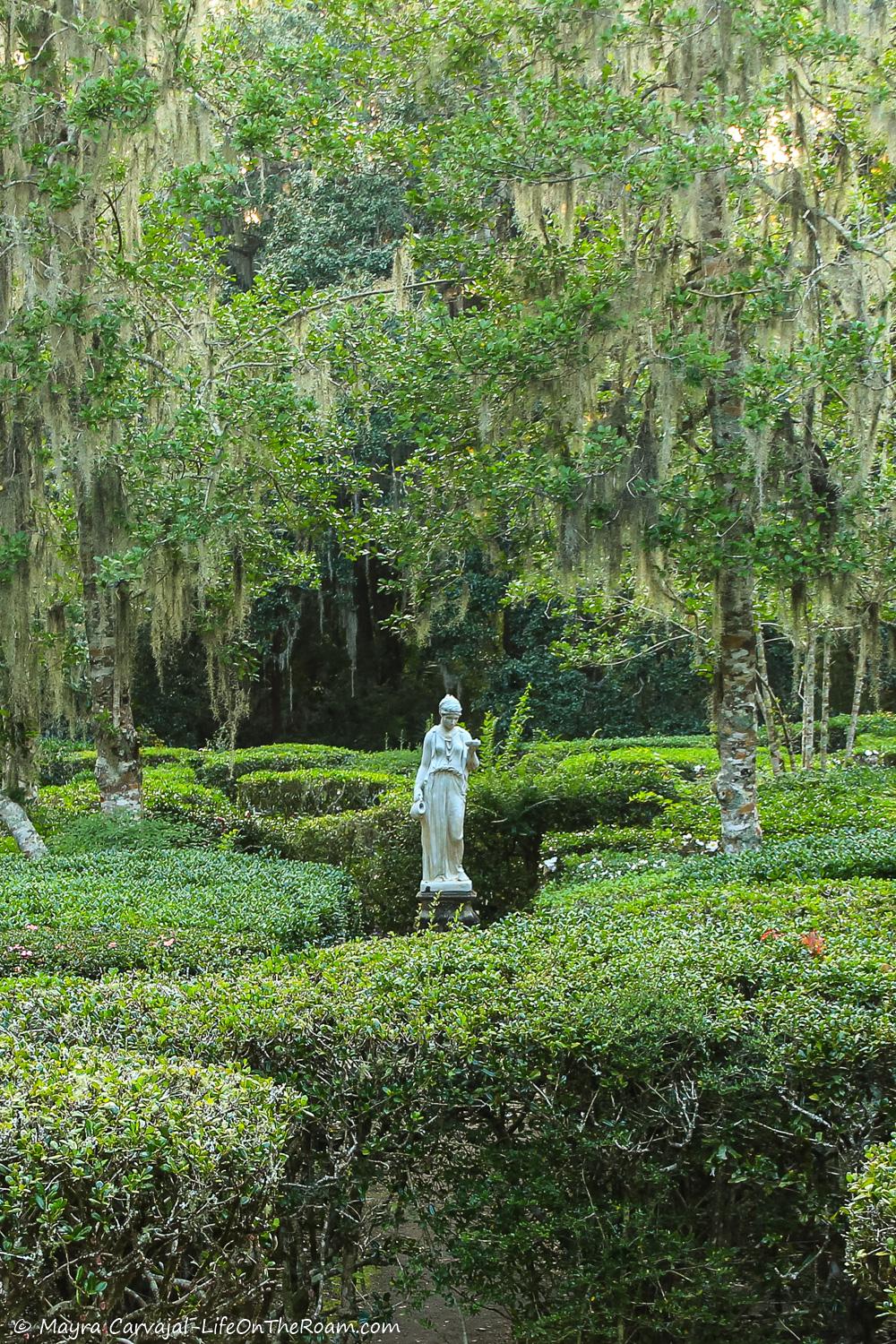
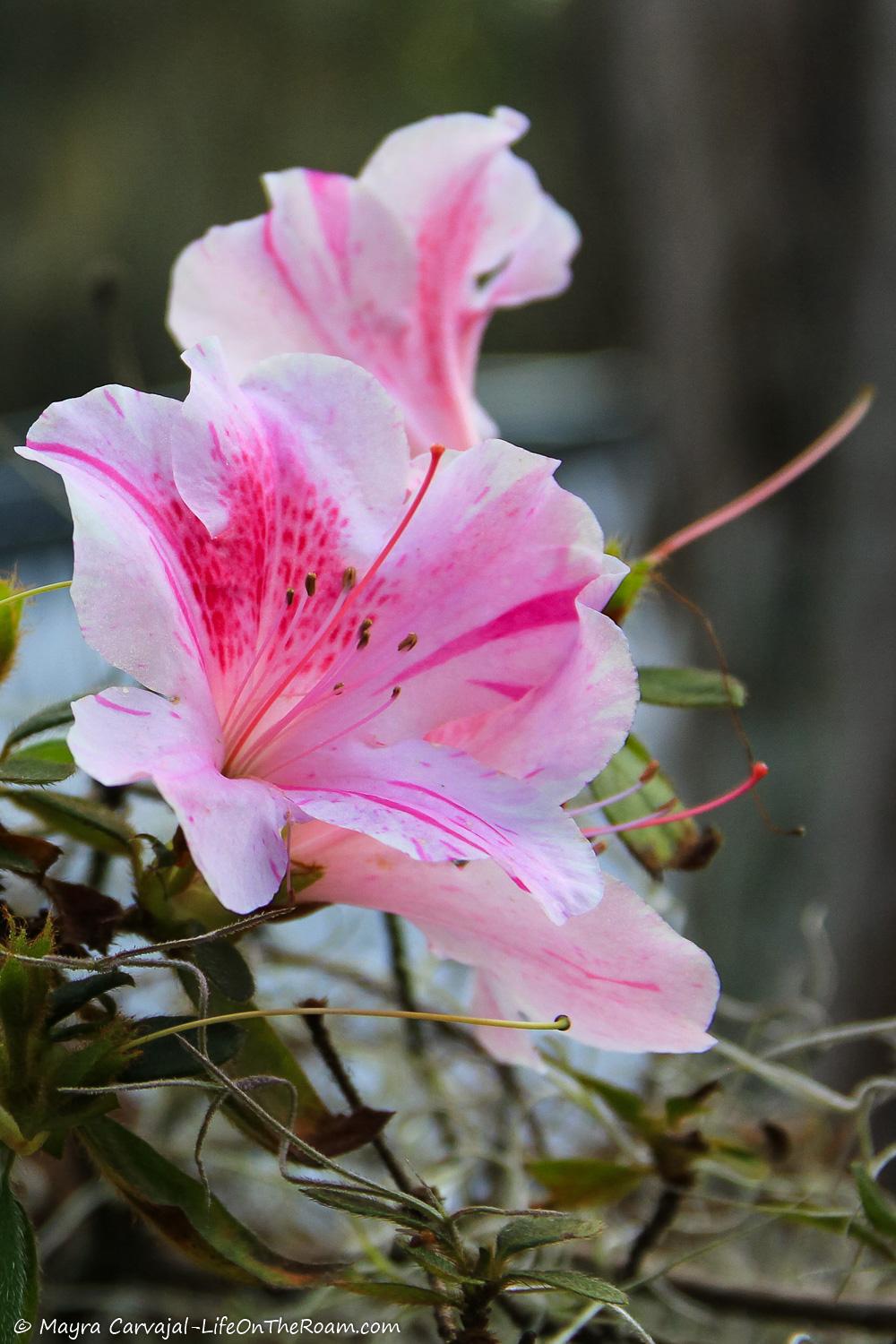
Magnolia Plantation is one of the best spots in the country to see azaleas. It’s not limited to the Azalea Garden though, as you can see them all around.
You’ve read a lot of “Oldest [insert name here] in America” throughout this post and you’re about to read one more.
Magnolia has the oldest collection of Indica Azaleas in America and in the 1840s it became the first garden to plant azaleas outside.
You’ll see hundreds of varieties in a multitude of colours.
From here you’ll find your way to the Horticultural Maze where you’ll have fun figuring out your way out.
CREATE ART WITH THE BEAUTY OF NATURE
Let your inner artist take over and bring to life these hand-drawn colouring pages for adults, featuring imaginary gardens.
Express your creativity and relax by applying your own palette to 50 original illustrations.
Print them at home, download them to your colouring app, or buy them as a gift to your art and nature loving friends.
See a preview and get yours today
The Historic House
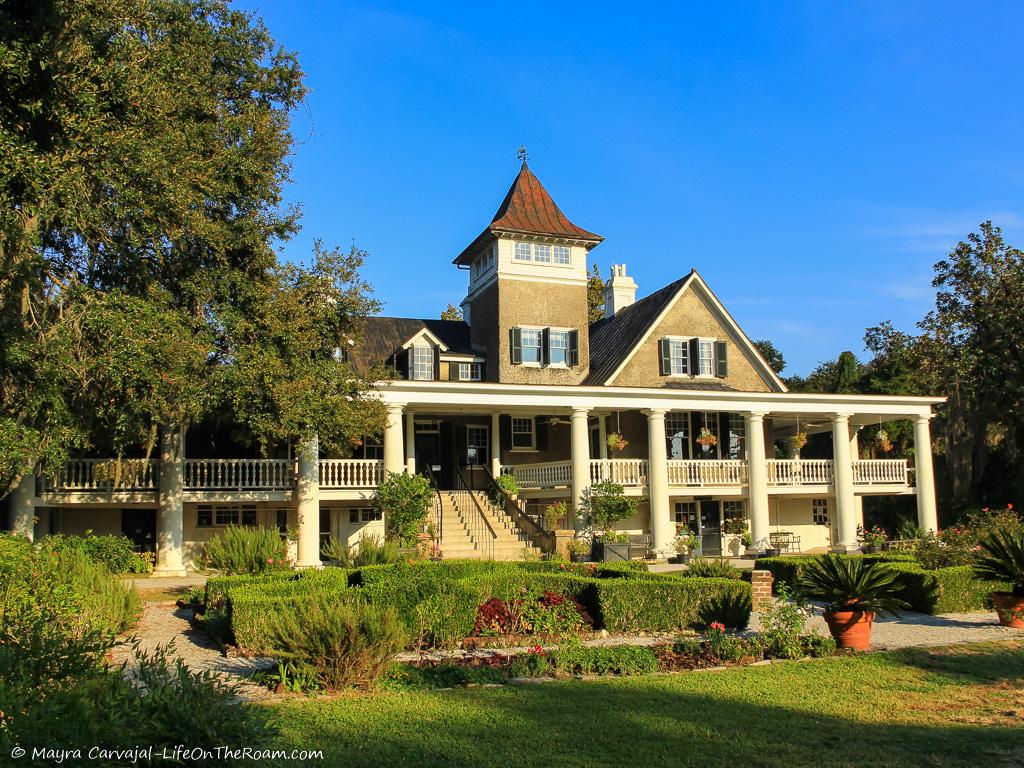
As you walk across the gardens you’ll see a big house with a wraparound porch. This is not the original house. That one was located near the Flowerdale Garden and was destroyed in a fire in 1800.
Then during the Civil War General Sherman’s Union troops burnt the house, but the ground floor survived. Drayton sold part of the property to build the second floor on top of what was left.
So this is kind of the third house and more of a late 19th-century one rather than an antebellum mansion.
It’s a beautiful house that is open for guided tours, which you must purchase separately.
Walking along the paths with flowers greeting my way under the shade of the trees was as enjoyable as discovering the small enclaves hiding little treasures.
Slavery at the Magnolia Plantation
As I strolled through the garden I travelled back in time looking at plaques with historic photographs taken more than 100 years ago, at the same spot where I was standing. You can see how the garden has changed, and how it has stayed the same.
I saw women and girls wearing big, puffy, elegant 19th century dresses.
But beyond the rosy picture of ladies taking a leisure walk in pretty dresses with big hats, there was another, not pretty reality.
I also spotted in the picture an enslaved man.
Slavery was the other side of the coin in this place that looked like paradise (for one side of the coin only).
In short, plantations were forced labour camps.
Enslaved people were forced to work in the rice fields enduring the sun and the heat day in day out, standing on mud, surrounded by bugs and snakes. Slavery ended after the Civil War.
Going back even further you can trace the dark history to the colonization era, when the “Cusabos” (the tribes grouping the local indigenous people) were enslaved or decimated when they were no longer needed after the growth of the colony, to the satisfaction of the governors as they had more room for “their people”.
If you want to know more about the other side of history you can take the From Slavery to Freedom: The Magnolia Cabin Project Tour.
You’ll learn about the different periods of African-American history and how the people living in the now restored slave quarters transitioned from being enslaved to being paid workers to design, create, and maintain the gardens, and work as tour guides.
Some of the descendants of people who lived here work for Magnolia today.
This tour is now included with the general admission, but reservations are required.
The Wildlife Observation Tower and the Ancient Dams

Take a walk through the windy paths until you approach the Wildlife Observation Tower.
From the top, you’ll see a river marsh that was used before the Civil War to cultivate rice.
Now, this is a wildlife refuge from where you can spot birds, turtles and alligators.
But right before you reach the tower you’ll find one of my favourite environments: a swamp with bald cypress trees.
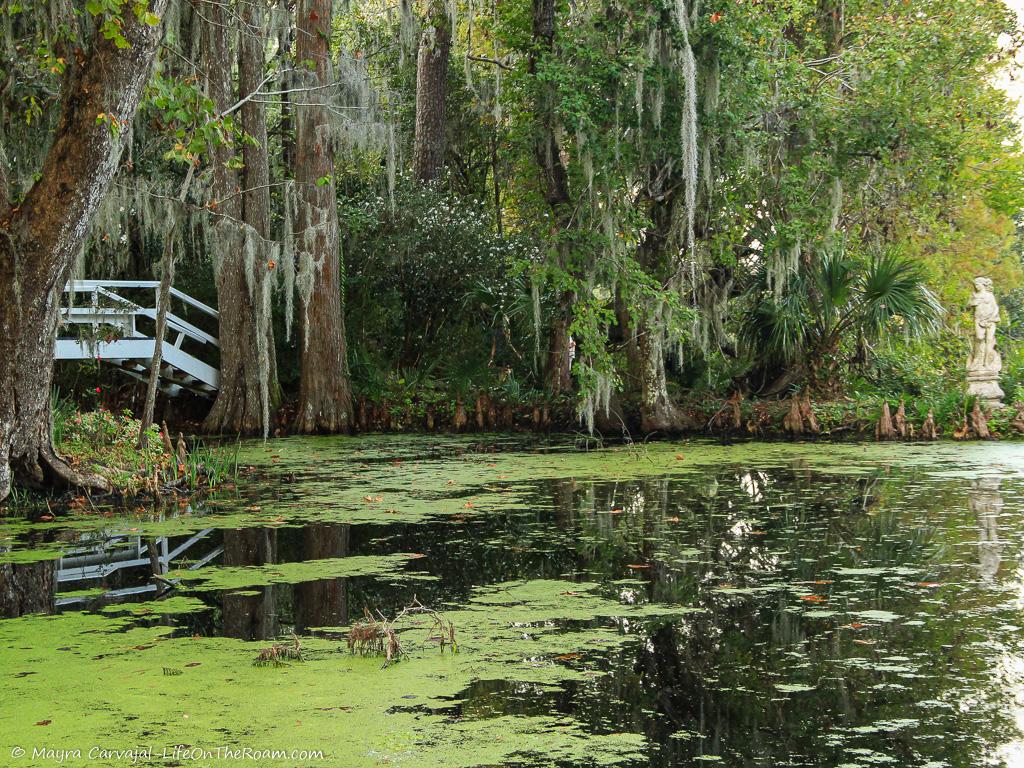
According to the sign near the site, this area was a marsh slip turned into a controlled rice field by building a dam, before the Revolutionary War.
Now you can see the curious cypress knees (the knobs sticking out of the water), that provide oxygen to the tree.
Why is the water black? Thank the tannic acid released by the cypress roots for that.
Aren’t swamps magical?
The Petting Zoo (with rescue animals)
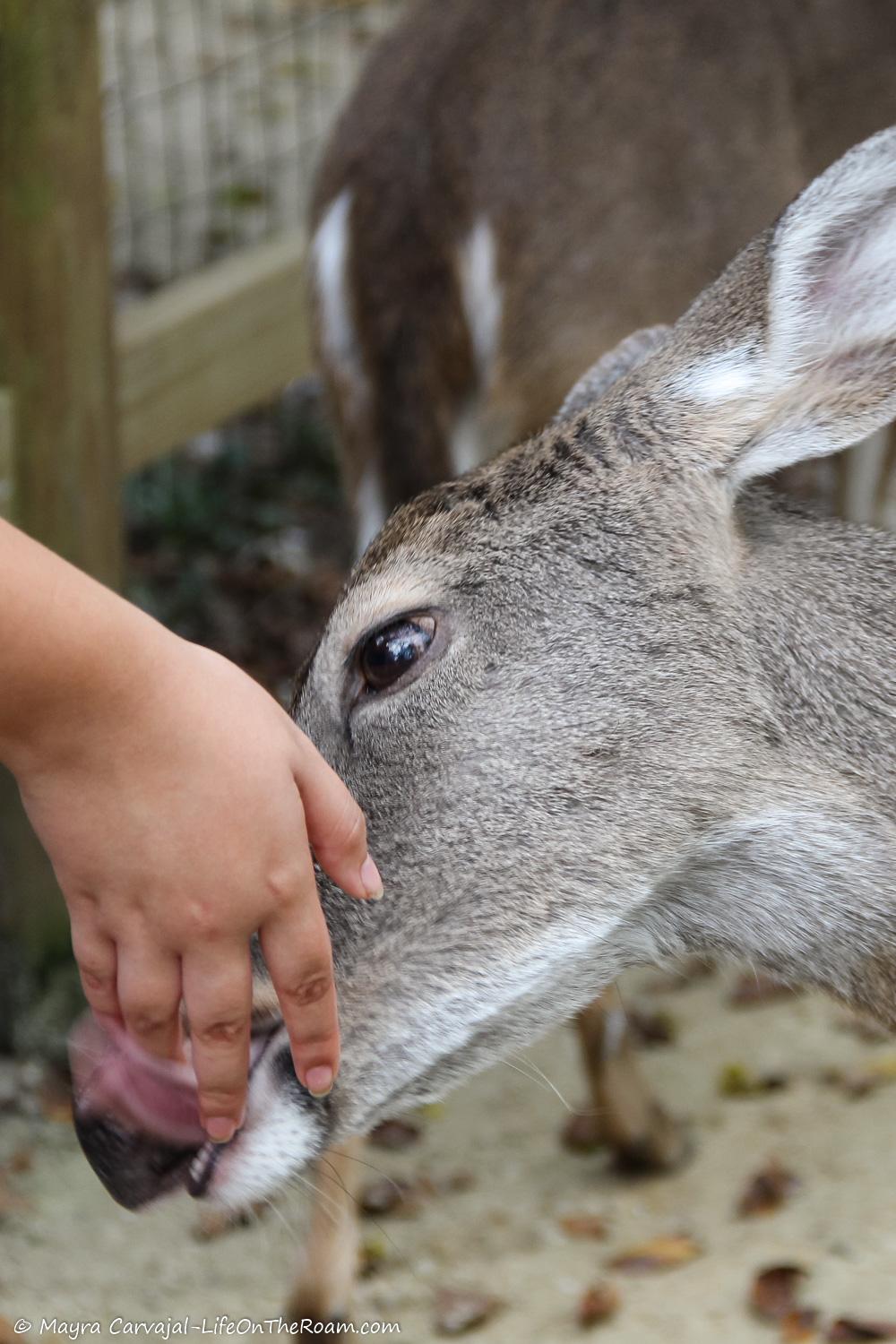
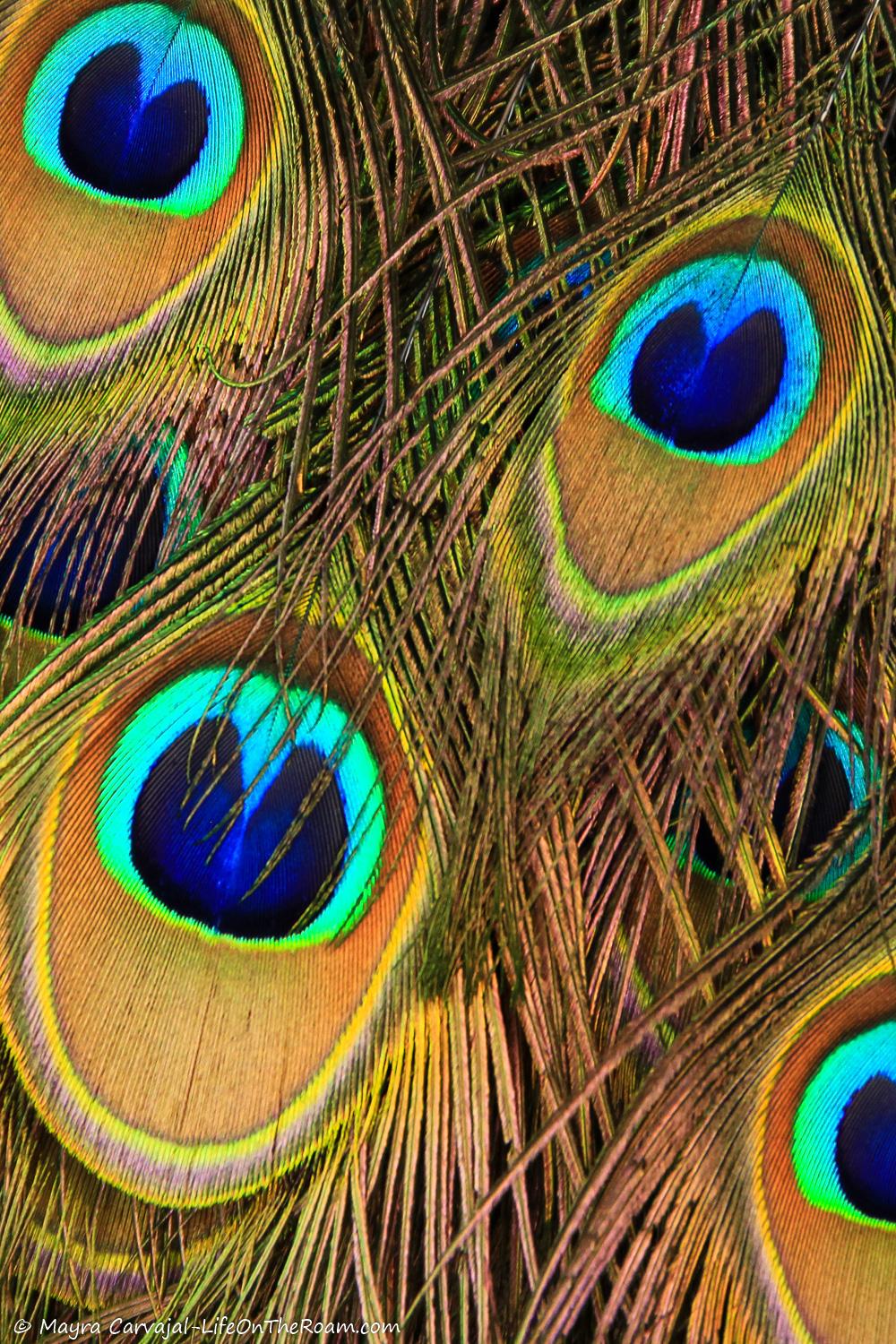

I’m not a fan of zoos, but I like that this facility is home for rescue animals and that it educates people about wildlife (and why it’s never a good idea to try to turn a wild animal into a pet).
You’ll learn about the habits of the residents and why they ended up there (some were injured and unable to go back to the wild, some were confiscated by wildlife officials, and some were orphans).
You’ll be able to pet some of them (deer and goats), but not all of them. Some animals you can see include Eastern screech owls, Great Horned Owls, foxes, racoons and bobcats.
And don’t miss the peacocks running and flying around the Peacock cafe.
The Conservatory
My last stop at the gardens was the Conservatory, a greenhouse with statues, gorgeous orchids and other tropical plants.
The Magnolia Plantation and Gardens is a fabulous venue to spend an entire day outdoors enjoying nature. Add this stop when you plan your next trip to Charleston.
There is a cafe on site but you can bring your own food and use the picnic tables set across the property.
Explore the grounds even further by going on the bike trails and learn more about its wildlife by taking a bird walk tour (not included in the general admission).
Other activities you can enjoy but are priced separately, are a visit to the Audubon Swamp Garden, a ride on a nature boat, and a Nature Tram.
Magnolia Plantation and Gardens
3550 Ashley River Road; 1.843.571.1266 or 1.800.367.3517; Open everyday : 9AM to 5PM (last admission at 4PM);General Admission: US$32.00; Pets allowed (must be leashed at all times)
YOU MAY ALSO WANT TO READ
BOOKING FLIGHTS AND ACCOMMODATIONS
Book your flight without losing your shirt
We check Momondo to find great deals to book our flights. Also, check Great Escape: it combines the listings from Expedia, Kiwi, Kayak, (and Skyscanner on the premium service) to find the best airfares.
To find a place to stay for less
Booking.com: this site combines everything under the sun. You’ll find hotels, apartments, B&B, hostels, rooms, etc., with all sort of filters to make your search a breeze.
Hotwire: the first site I check when we plan to stay at a hotel for a few nights. You can save anything from 20% to 60%. Use the search filter to find what you want and you’ll end up with three listings that match your criteria. You’ll know which one you’ll get after you book. If you can handle a little bit of uncertainty you can score big savings.
House Sitting: you take care of people’s pets and house for free while staying for free. It’s the closest thing to experiencing a place “like a local”. But it comes with responsibilities… Are you an animal lover? It may become your new way to travel.
To get travel insurance
SafetyWing: travel medical insurance that gives us peace of mind knowing that we’re covered in case of emergency. It’s convenient, affordable, and suitable for digital nomads who spend a long time outside their home country.
Check the full list of travel resources on my Resource Page for more options and savings

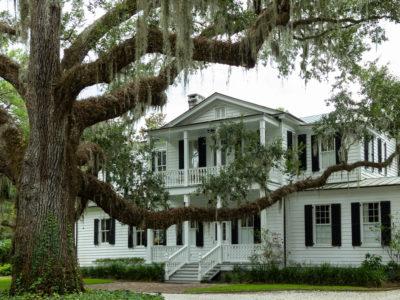
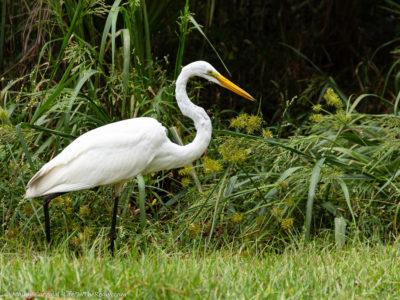
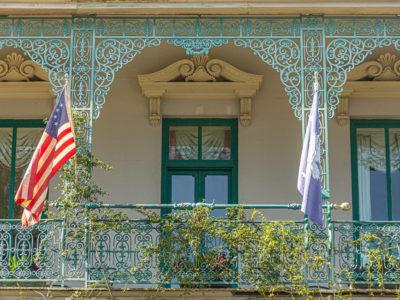
What a gorgeous garden 😍 Gonna have to add it to the travel list!
It’s gorgeous and it’s also great for seeing wildlife. Enjoy!